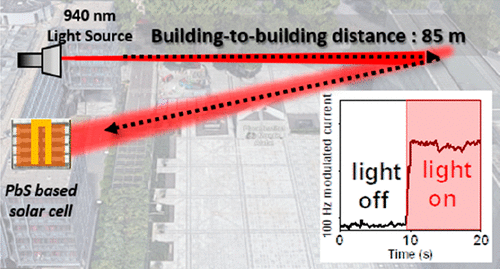当前位置:
X-MOL 学术
›
ACS Photonics
›
论文详情
Our official English website, www.x-mol.net, welcomes your feedback! (Note: you will need to create a separate account there.)
Potential of Colloidal Quantum Dot Based Solar Cells for Near-Infrared Active Detection
ACS Photonics ( IF 7 ) Pub Date : 2019-12-10 , DOI: 10.1021/acsphotonics.9b01542 Julien Ramade 1 , Junling Qu 1 , Audrey Chu 1, 2 , Charlie Gréboval 1 , Clément Livache 1, 3 , Nicolas Goubet 1, 3, 4 , Bertille Martinez 1 , Gregory Vincent 2 , Emmanuel Lhuillier 1
ACS Photonics ( IF 7 ) Pub Date : 2019-12-10 , DOI: 10.1021/acsphotonics.9b01542 Julien Ramade 1 , Junling Qu 1 , Audrey Chu 1, 2 , Charlie Gréboval 1 , Clément Livache 1, 3 , Nicolas Goubet 1, 3, 4 , Bertille Martinez 1 , Gregory Vincent 2 , Emmanuel Lhuillier 1
Affiliation

|
Nanocrystal-based solar cell technologies currently have two materials competing for the highest performances: PbS and perovskites. The latter benefit from a defect-tolerant electronic structure, while PbS benefits from mature diode fabrication techniques and from its near-infrared absorption. Here we choose to revisit the potential of PbS photodiodes for near-infrared detection and more precisely for active imaging. This mode of detection combines an eye-invisible source with a detector. Such a detection mode is used for surveillance, industrial sorting, LIDAR, etc. Here we use a state-of-the-art photodiode geometry, and we reveal its potential for near-IR active detection at 940 nm. The diode achieves a high photoresponse of 0.5 A.W–1, corresponding to an external quantum efficiency of 66% and a detectivity above 1012 Jones at room temperature. The time response, which is often neglected for solar cells, is found to be 10 ns for rise time and 1 μs for decay time. We demonstrate that long-distance (over 150 m) and time-gated active imaging can be conducted using this device.
中文翻译:

基于胶体量子点的太阳能电池近红外主动检测的潜力
目前,基于纳米晶体的太阳能电池技术有两种材料在争夺最高性能:PbS和钙钛矿。后者受益于容错的电子结构,而PbS受益于成熟的二极管制造技术及其近红外吸收。在这里,我们选择重新探究PbS光电二极管在近红外检测以及更精确地在主动成像方面的潜力。这种检测模式将眼睛不可见的源与检测器结合在一起。这种检测模式可用于监视,工业分类,激光雷达等。在这里,我们使用最先进的光电二极管几何形状,并揭示了其在940 nm处进行近红外有源检测的潜力。二极管可实现0.5 AW –1的高光响应,对应于66%的外部量子效率和在室温下高于10 12 Jones的探测率。发现对于太阳能电池通常忽略的时间响应,上升时间为10 ns,衰减时间为1μs。我们证明了可以使用此设备进行远距离(超过150 m)和时间门控的主动成像。
更新日期:2019-12-10
中文翻译:

基于胶体量子点的太阳能电池近红外主动检测的潜力
目前,基于纳米晶体的太阳能电池技术有两种材料在争夺最高性能:PbS和钙钛矿。后者受益于容错的电子结构,而PbS受益于成熟的二极管制造技术及其近红外吸收。在这里,我们选择重新探究PbS光电二极管在近红外检测以及更精确地在主动成像方面的潜力。这种检测模式将眼睛不可见的源与检测器结合在一起。这种检测模式可用于监视,工业分类,激光雷达等。在这里,我们使用最先进的光电二极管几何形状,并揭示了其在940 nm处进行近红外有源检测的潜力。二极管可实现0.5 AW –1的高光响应,对应于66%的外部量子效率和在室温下高于10 12 Jones的探测率。发现对于太阳能电池通常忽略的时间响应,上升时间为10 ns,衰减时间为1μs。我们证明了可以使用此设备进行远距离(超过150 m)和时间门控的主动成像。



























 京公网安备 11010802027423号
京公网安备 11010802027423号